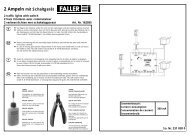INSTRUCTION MANUAL
INSTRUCTION MANUAL
INSTRUCTION MANUAL
Create successful ePaper yourself
Turn your PDF publications into a flip-book with our unique Google optimized e-Paper software.
Page 52<br />
Decoder MX620 - MX622, MX630 - MX632 Sound Decoder MX640 - MX648<br />
Connecting servo and<br />
SmartServo motors:<br />
2 servo control outputs are available on the<br />
MX620, MX630. MX632 and MX640 decoders<br />
for the control of commercially<br />
available servo motors or SmartServo RC-<br />
1 (Manufactured by TOKO Corp. Japan).<br />
The servo solder pads or pins on the 21-<br />
pin or PluX connector can also be used alternatively<br />
for SUSI or as logic level outputs.<br />
The SUSI and logic level functions are not<br />
available if the servo mode is activated<br />
(through CV’s #181 and 182, see below);<br />
this is also true for the function outputs<br />
FO5 and FO6 on the MX632.<br />
The models MX632W and MX632WD contain<br />
a 5V power supply to power servos<br />
directly; the 5V supply on the MX640 is<br />
limited to 200mA.<br />
For other decoder types, the 5V must be<br />
supplied by an external voltage regulator<br />
such as the readily available LM7805;<br />
connected as shown in the drawing.<br />
The outputs can be activated for servo<br />
control duty with CV’s #181 and CV #182<br />
(the value in each must be different than<br />
0).<br />
With the help of CV #181 and #182, the<br />
servo functions can be mapped to various<br />
function keys (plus direction) and selected<br />
for control with either one or two function<br />
keys.<br />
CV’s #161 to #169 define the servos end<br />
positions and rotating speed, see CV table.<br />
CV #161 also defines the appropriate servo<br />
protocol. “Normal” for most servos is<br />
positive pulses (which is also the default<br />
setting); furthermore a selection can be<br />
made whether the servo is powered only<br />
while it is being moved or remains powered<br />
at all times. The latter should only be<br />
used if the servo position could change by<br />
outside mechanical influences.<br />
Connecting MX640 and MX642 to servo and SmartServo motors:<br />
Two servo connections are provided on the MX640 for commercially available servos and SmartServo<br />
RC-1 (Manufacturer: TOKI Corp., Japan). These are normally the SUSI outputs but can also be<br />
used as servo outputs instead. The connections are in the form of either solder pads or part of the<br />
21-pin socket, depending on the decoder type. Each output can be connected directly with a servo<br />
input.<br />
“Energy-saving” servos (max. 200mA) can be powered directly by the MX640!<br />
For servos with higher energy consumptions, the 5V operating voltage must be supplied by an external<br />
voltage regulator such as the readily available LM7805 as shown in the drawing.<br />
The outputs can be activated for servo control duty with CV’s #181 and CV #182 (the value in each<br />
must be different than 0). With the help of CV #181 and #182, the servo functions can be mapped to<br />
various function keys (and direction) and selected for control with either one or two function keys.<br />
CV’s #161 to #169 define the servos end positions and rotating speed, see CV table.<br />
The appropriate servo protocol can be selected with CV #161. “Normal” for most servos is positive<br />
pulses (which is also the default setting); furthermore a selection can be made whether the servo is<br />
powered only while it is being moved or remains powered at all times. The latter should only be used<br />
if the servo position could change by outside mechanical influences. For the SmartServo: Bit 1 of<br />
CV #161 must always be set, that is CV #161 = 2!










